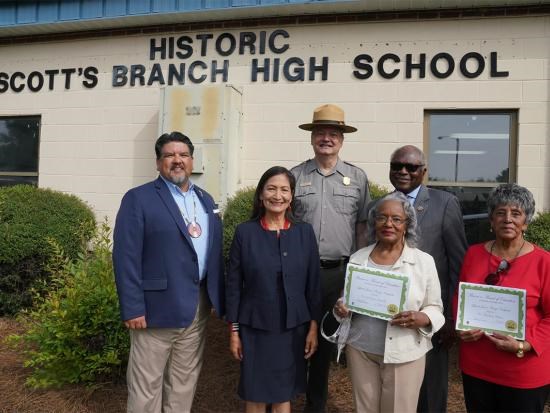Part of a series of articles titled Superintendent Articles about Brown v. Board of Education NHP.
Article
Telling the Whole, and Sometimes Difficult, Stories

DOI photo
It is our solemn responsibility at the Department of the Interior, as caretakers of America’s national treasures, to tell the whole, and sometimes difficult, story of our nation. These stories are not always easy. And they can be traumatic. But it is my duty to ensure that they are told. Because our story, is America’s story.—Secretary of the Interior Deb Haaland at Scott’s Branch High School, a future addition to Brown v. Board of Education National Historical Park in Summerton, South Carolina, September 27, 2022.
In our interactions with the public—whether in person at the Monroe School in Topeka, online through our website, or in the communities with which we interact—we attempt “to tell the whole, and sometimes difficult, story of our nation.” We have a “hall of courage” in our exhibits that simulates the experience of Black students who confronted angry Whites shouting racial slurs as the students entered previously-segregated schools. We warn visitors that they may find the experience upsetting, and we do not bleep out the “n word” in the historical film footage. Reaction from visitors confirms that for many, this is a powerful tool to understand the struggles that Black Americans faced in the 1950s.
As the first Native American secretary of the interior, Deb Haaland understands historical trauma. She has undertaken a “healing tour” through Indian Country in an effort to recognize the trauma that the Department of the Interior itself has inflicted on Native Americans and other minority groups. Similarly, the National Park Service in its history has displaced Native Americans, poor White Appalachians, and other American people in the creation of national parks during an era in which these people were seen as obstacles to a “pristine” natural landscape.
As an agency, while we recognize and attempt to heal the trauma we have inflicted in the past, we struggle ourselves with how to present the truth of American history without inflicting more trauma on visitors and the victims of the oppressive educational policies we interpret. “Comfort is the enemy of progress” is a famous quotation from showman P.T. Barnum. We can choose to wrap ourselves in the comfortable stories that are part of American history. This has been a common approach throughout America’s past. But progress has only come when we have the courage to learn about the uncomfortable, even horrendous, parts of our national past.
The questions we wrestle with every day include:
- When we quote from or present historical documents that express racism, hatred, and other ideologies widely condemned today, do we somehow give credence to those ideas?
- Can we find the truth of the past for ourselves and our visitors by “toning down” the unpleasant episodes of our collective past?
- Are we providing a place of reckoning, reconciliation, and healing where we can share stories and discuss the past? Or are we inflicting more trauma on those who experienced it and continue to experience it in their lives today?
This work is not easy, nor is it always comfortable.
Looking ahead, Brown v. Board of Education National Historical Park is participating in the America 250 commemoration coming up in 2026: “The journey toward this historic milestone is an opportunity to pause and reflect on our nation’s past, honor the contributions of all Americans, and look ahead toward the future we want to create for the next generation and beyond.” We are also revising and reimagining how we tell the story of the Brown v. Board of Education decision and its many legacies as we approach the decision’s seventy-fifth anniversary in 2029. We cannot succeed without the engagement of Americans across the country. We welcome your participation and feedback.
James H. Williams, PhD
Superintendent
May 2024
Last updated: May 30, 2024
